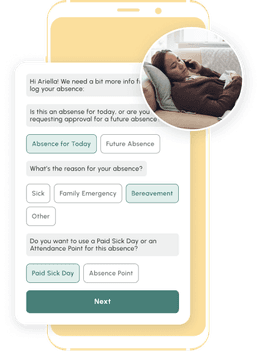When to HR with AI (and When Not To)!
Do your frontline employees dread showing up for their shifts at work, or are they excited and motivated about the challenges they’ll face each day?
If it’s the former, you’ve got a big problem. Low employee morale is one of the biggest factors impacting workplace productivity, leading to higher absenteeism, more workplace accidents, and lost revenue. As a result, low morale costs U.S. businesses $550 billion each year.
And it’s an issue that many workplaces need to urgently address: In fact, in 2023, only 33% of employees were actively engaged at work, and said that they had less clarity around expectations, lower levels of satisfaction, and less connection to the company’s mission than they did four years before.
For the HR team, it’s imperative that your company creates an actionable strategy to engage your frontline employees in a positive workplace culture. You’ll need to regularly monitor your team’s engagement levels, and identify new ways to boost morale when it’s sinking.
This can be challenging, particularly if your budget is limited—but there are many highly-effective tactics for boosting team morale without breaking the bank. In this guide, we’ll talk through some ways to do that.
Why Employee Morale Is Important
The Connection Between Morale and Performance
Engaged employees—who are psychologically invested in their work and care about its culture—have lower absentee rates, better customer support, and higher productivity, resulting in higher profitability for their companies. Gallup found that business units with highly engaged employees (top 25%) outperform the lowest 25% by 10% on customer ratings, 22% in profitability, and 21% in productivity. They also saw much lower turnover, shrinkage, and absenteeism. Morale plays an impact on work safety and quality as well, with fewer safety incidents, patient safety incidents, and quality defects.
The Cost of Low Morale
Simply put, disengaged employees are a liability to your business. Employees who don’t care about their work are more likely to call out or no-show, leaving you understaffed and overstressing the employees who do show up.
And even when disengaged workers are present, they’re not likely to work as hard, or take as much care with their work, as engaged employees, leading to quality control issues and the potential for dangerous mistakes. Employees with low morale are also much more likely to leave for other opportunities: Turnover rates were 59% higher for business teams with low morale than highly engaged teams, leading to much higher recruiting and training costs associated with replacing lost workers.
Signs That Employee Morale Needs a Boost
Want to understand how your organization’s employee morale compares to others? Here are some ways to find out:
Assess key metrics
Look at company-wide metrics such as your absenteeism (including sick leave and no-shows) and punctuality rates to get a good barometer of your employee engagement. Also pay close attention to your company’s output: How productive are your employees and teams over time, and can you tie changes in performance to any trigger events? Using AI tools to help you assess your employee data will help you illustrate trends in engagement, and show you which employees or teams are most and least engaged.Ask your employees directly
Beyond looking at the numbers, you can find out how your employees are feeling by simply asking them! Consider using pulse surveys to get a real-time assessment of your employees’ outlook around their jobs, and request feedback around particular initiatives, such as new technology or training procedures. You can also conduct focus groups or build employee resource groups to collect in-depth feedback on what’s going well and how the company could better serve its workers.Track HR complaints and external reviews
If employees are dealing with toxic bosses and coworkers, they’re not all likely to keep it to themselves. Pay close attention to the HR complaints you receive, and analyze whether you’re frequently receiving complaints about the same managers or workers, or whether the problems are systemic. You can also look at your company’s reviews on Glassdoor, Indeed, and other external sites to get a sense of how your brand is perceived by its employees, and whether frontline staff has a different experience to corporate staff.

The Costly Impact of Absenteeism on Manufacturing Operations
Learn how chronic, unplanned absenteeism is a costly impediment to manufacturing productivity and efficiency, and how you can reduce absenteeism.
Simple Ways to Boost Employee Morale in the Workplace
Create a Culture of Appreciation
One of the easiest and most effective ways to drive higher workplace morale is to show your employees that their hard work isn’t going unnoticed. By building recognition and acknowledgement into the workplace culture, you’ll be able to build a better relationship with your team. Some ways to do that include:
Verbal recognition
When employees are performing well, be sure to acknowledge their work and share your appreciation for what they’ve done. Gallup found that recognition from a direct manager was most impactful (28%), followed by a high-level leader or CEO (24%), the manager's manager (12%), a customer (10%) and peers (9%). And be consistent with your praise: Gallup recommends commending your employees at least once a week to continually keep morale high.Employee shoutouts & recognition boards
Create a culture of publicly celebrating wins when team members go above and beyond, whether by calling out accomplishments in meetings, holding award ceremonies, or using a leaderboard app to showcase top-performing employees.Personalized notes & emails from leadership
Encourage your managers and executive team to write notes of appreciation to a handful of employees each week—just a quick note can have a big impact on employees’ morale, and show them that their hard work is being recognized at all levels of the organization.
Encourage Work-Life Balance
Building programs that support a healthy work-life balance has been shown to lower stress and increase employee retention: Employees who say they have a healthy work-life balance are 10% more likely to remain at their organization. Implement these tips to help boost employee work-life balance:
Encourage mini-breaks
Encouraging workers to take short breaks in between tasks can lower their stress levels and increase productivity. Provide comfortable break areas that are supplied with water and snacks, and make breaks part of the daily routine.Flexible work options
When possible, give employees more control over their schedules so that they can plan around outside commitments. By using a shift scheduling tool, you can ask team members to set their preferred shifts and automatically build a schedule that’s aligned with their requests.Wellness initiatives
Encourage movement, mindfulness, and stress relief in the workplace, with opportunities to take part in yoga, exercise, and even guided meditation exercises.
Foster a Positive Team Environment
Build an open company culture, where employees look out for one another and feel heard by their leadership. By building trust in the workplace community, you’ll ensure that workers feel invested in what they’re doing. Consider these tactics:
Team-building activities
Offer occasional team-building activities that don’t feel forced, such as offering a paid volunteer day where team members can connect on a common project, or planning a team-wide cookoff or potluck meal.Workplace traditions & rituals
Encourage managers to set up regular events to celebrate their employees, such as weekly donuts or hot breakfast, and a monthly birthday celebration complete with cake for all employees who had a birthday that month.Encouraging open communication
To feel invested at work, employees need to feel like they have a voice. Make sure that they have accessible avenues for communicating with their managers and executives, such as a text-based app that empowers them to share feedback with the corporate team.

Fun Ways to Celebrate Your Frontline Team
Even if your managers don’t have much money available to spend on employee engagement, a little can go a long way. Here are some ways to boost morale on a budget:
Gamify the Workplace
Encourage employees to participate in friendly challenges, using a leaderboard to show, for example, which employees or teams are achieving the highest productivity rates over a certain period of time. Give the winning employee or team a reward, such as a gas gift card or an extra day off. You can also award employees with badges or recognition for meeting key milestones, such as a year of service.
Surprise & Delight Employees
Offer up affordable treats like a pre-paid meal from a local food truck or a lunchtime pizza party. And while you likely can’t splurge on pricier items for your entire team, consider setting up a raffle with a desirable prize, like a Yeti tumbler or a Home Depot chair, as one employer does. All employees in good standing will be automatically entered in the raffle, and you can randomly select a winner for the prize each time it’s offered.
Boost Employee Morale With Better Leadership
The most significant ways to boost morale aren’t focused on perks and pizza parties, however—they’re centered on building a relationship of trust and respect between employees and leadership. Here are some ways that your company’s managers can deepen their relationships with their teams:
Empower Employees with Autonomy
One of the easiest ways to gain trust and respect from your employees is to show that you trust and respect them. Micro-managing is your enemy here: As your team members demonstrate mastery of their work, managers should be providing them with more opportunities to make independent decisions and show their expertise. When possible, give them the flexibility to be creative in their work and foster innovation. Transparent communication throughout the business is also critical: Employees should have opportunities to learn about upcoming initiatives at your business and to provide feedback for review, whether through email, text, or one-on-one meetings.
Support Career Growth & Development
If employees don’t see any growth potential at your company, they’re not likely to stick around for long. To ensure that they stay engaged, it’s important to build internal workforce development programs that help employees build the skills they need for their next opportunity within your company. You can provide them with access to free training and online courses, and one-on-one mentorship from a colleague. Work with each employee to show them a clear growth path within their role, and connect them with training and mentorship opportunities that will help them uplevel their skills faster.
Improve Communication & Transparency
Openness and transparency is key to building an engaged workforce. In fact, 84.2% of employees at highly transparent companies said they were satisfied with their employers, compared to 54.4% of employees at companies that lack transparency.
To build a transparent company culture, it’s important to set a cadence of regular check-ins and all-hands meetings to keep all employees in the loop around current and upcoming initiatives. For any changes that are likely to impact their work, such as changes to technology or training process, it’s important to provide a thorough briefing and provide your team with the chance to ask questions and address concerns.
It’s also important that employees feel safe bringing their issues to their managers and to your HR team. Make sure that you have clear HR policies that are accessible to employees in their native languages, which they should be able to review through a text-based platform like TeamSense. Provide them with a variety of options for addressing issues, including written notices, phone-based communication, and in-person meetings. By creating a safe space for citing concerns, you’ll be better equipped to address issues before they grow.

No one wants to talk to their boss or a 1-800 stranger to call off. Text changes everything - Reducing No Call No Shows.
How Supervisors Can Boost Morale & Motivation
For frontline workers, their experience of the workplace will largely be defined by their supervisor’s management style. If their boss is positive and supportive, they’re likely to think highly of the workplace—but if they’re saddled with a critical boss with unrealistic expectations, they’re likely to experience low morale, and may soon start looking for greener pastures.
Here are some tips for ensuring field managers are able to keep their team’s morale high:
Lead by Example
As Mahatma Gandhi said, “Be the change you wish to seek.” Rather than take a distant and hands-off approach to management, supervisors should actively engage in the team’s work, and jump in to lend a hand when they see their employees getting overworked. Encourage them to learn all of their employees’ names and get to know them as individuals, and to be lenient with team members who are sick or have family emergencies. By showing empathy to their employees, they’ll be able to hold on to good team members and nurture their growth over time.
Set Clear Goals & Celebrate Achievements
It’s important for supervisors to be realistic around outcomes. While the corporate office may set out lofty production goals, supervisors know that achievements may be limited based on factors such as labor and equipment shortages. Managers should regularly update goals and production schedules based on available staff and resources, setting up ambitious, but realistic, production goals.
Supervisors should also avoid the temptation to micromanage their teams: Once employees have been adequately trained, managers should trust them to complete their work independently and seek out support if they need it, rather than offering unsolicited feedback. They can track metrics associated with productivity to understand which team members may need additional support or training, and follow up with additional guidance in these cases. They’ll also be able to use the data to identify top performers, and can celebrate and reward their achievements.
Be Available & Supportive
Field managers should walk the line between empowering autonomy and offering oversight to employees who need it. They can rely on operational data, as well as direct input from their staff, to determine when to intervene in a situation. By striking the right balance, they’ll be able to build their team members’ confidence in their abilities, while providing them with reassurance that they have access to support if and when they need it.
When team members are facing challenges, whether with their work itself or with outside issues that may interfere with work (sickness, transportation problems, family issues), supervisors should take the time to understand the issue and offer tips for successful resolution, rather than criticism. They can work together with your HR team to ensure that frontline workers are taking advantage of their benefits, and give them tips on strategically using their paid leave so that it doesn’t impact their job security or advancement opportunities.
Small Changes Make a Big Difference
Boosting employee engagement is not a one-and-done process—everyone at the company, from site supervisors up to executive leadership, should regularly focus on strategies for building a positive workplace culture for their teams. By regularly keeping a pulse on your employees’ morale levels, your HR team will be able to enhance recruitment efforts, boost workplace productivity, and increase your employees’ retention rates.
As an HR pro, you have a key role to play in fostering employee engagement throughout the organization. Start strong by adopting best-in-class technology tools that will help your frontline employees connect with their supervisors and corporate leadership, with functionality including notifications, text-based messaging, absence reporting, and leave management. Employees should be able to easily seek out benefits and policy information, and communicate effortlessly with your HR team around workplace issues, leave requests, and absence notifications.
By employing technology to foster a highly transparent and efficient workplace, you’ll be able to boost team engagement and ensure that your employees feel valued every day on the job.
Ready to get started? Try out a demo of TeamSense today.
About the Author

Jackie Jones, Employee Engagement & Attendance Specialist
Jackie Jones has over three years of experience helping HR teams improve employee morale, reduce absenteeism, and create happier, more engaged workplaces. With a strong background in employee relations and attendance management, she brings practical strategies and insights that support frontline teams and the HR professionals who lead them.


